Acid Resistance of Alkali-Activated Natural Pozzolan and Limestone Powder Mortar
Abstract
1. Introduction
2. Materials and Methods
2.1. Materials
2.1.1. Natural Pozzolan and Limestone Powder
2.1.2. Alkaline Activators
2.1.3. Aggregates
2.1.4. Acid Solution
2.2. Experimental Program
2.2.1. Mix Design for the Mortar Preparation
2.2.2. Mortar Preparation
2.2.3. Evaluation of the Resistance to Acid
2.3. Evaluation Methods
2.3.1. Water Absorption
2.3.2. Weight Loss
2.3.3. Compressive Strength
2.3.4. Binder Products Characterization
3. Results and Discussion
3.1. Characterization of Precursors (NP and LSP)
3.2. Effect of Binder Combination on Absorption
3.3. Visual Characterization in Acidic Exposure
3.4. Effect of Binder Combination on Change in Weight of acid Exposed Specimen
3.5. Residual Compressive Strength after Acid Attack
3.6. Mineralogy, Morphology, and Bond Characteristics of Mortar after Exposure to Acid Environment
3.6.1. XRD Characterization of AANL Binder
3.6.2. FTIR Analysis of Samples after Acid Attack
3.6.3. SEM and EDX Analysis of Samples after Acid Attack
4. Conclusions
- The mortar exhibited more expansion in the presence of a low volume of NP.
- The maximum strengths of 20.8 MPa and 6.68 MPa were noted in mortar developed using a high volume of NP (AAN60L40) and a low volume of NP (AAN40L60), respectively.
- The ultimate residual strengths were 16.8% and 1.4% for AAN60L40 and AAN40L60, respectively.
- The mass gains were 75.6% and −10.64% for AAN60L40 and AAN40L60, respectively.
- Samples synthesized using AAN60L40 (60% NP:40% LSP) exhibited no surface deterioration, while samples synthesized using AAN40L60 (40% NP:60% LSP) exhibited major surface cracks with minor multiple-edge delamination.
- The high sulfuric acid resistance of AAN60L40 mortar is attributed to the presence of high values of Si/Al = 7 and Ca/Si = 10 present in C-A-S-H and N-A-S-H products, which resulted in the pore-filling effects within the microstructure.
- The low strength recorded in AAN40L60 was due to the formation of gypsum in the binder product, whereas samples synthesized with a high volume of natural pozzolan (AAN60L40) showed more stability against acid attack.
- AAN60L40 exhibited the highest resistance to sulfuric acid attack.
Author Contributions
Funding
Informed Consent Statement
Data Availability Statement
Acknowledgments
Conflicts of Interest
References
- Godinho, J.P.; de Medeiros, M.H.F. Biogenic sulfur attack in a reinforced concrete sewage treatment plant. Re-visited mechanism and rehabilitation proposal. Eng. Fail. Anal. 2021, 124, 105354. [Google Scholar] [CrossRef]
- Madhuri, P.; Rao, B.K.; Chaitanya, A. Improved performance of concrete incorporated with natural zeolite powder as supplementary cementitious material. Mater. Today Proc. 2021, 47, 5369–5378. [Google Scholar] [CrossRef]
- Mustapha, F.A.; Sulaiman, A.; Mohamed, R.; Umara, S. The effect of fly ash and silica fume on self-compacting high-performance concrete. Mater. Today Proc. 2020, 39, 965–969. [Google Scholar] [CrossRef]
- Du, H.; Pang, S.D. Long-Term Influence of Nanosilica on the Microstructures, Strength, and Durability of High-Volume Fly Ash Mortar. J. Mater. Civ. Eng. 2021, 33, 04021185. [Google Scholar] [CrossRef]
- Liu, S.; Zhu, M.; Ding, X.; Ren, Z.; Zhao, S.; Zhao, M.; Dang, J. High-Durability Concrete with Supplementary Cementitious Admixtures Used in Corrosive Environments. Crystals 2021, 11, 196. [Google Scholar] [CrossRef]
- Kumar, M.; Sinha, A.K.; Kujur, J. Mechanical and durability studies on high-volume fly-ash concrete. Struct. Concr. 2020, 22, E1036–E1049. [Google Scholar] [CrossRef]
- Huseien, G.F.; Joudah, Z.H.; Khalid, N.H.A.; Sam, A.R.M.; Tahir, M.M.; Lim, N.H.A.S.; Alyousef, R.; Mirza, J. Durability performance of modified concrete incorporating fly ash and effective microorganism. Constr. Build. Mater. 2021, 267, 120947. [Google Scholar] [CrossRef]
- AlBiajawi, M.I.; Embong, R.; Muthusamy, K. An overview of the utilization and method for improving pozzolanic performance of agricultural and industrial wastes in concrete. Mater. Today Proc. 2021, 48, 778–783. [Google Scholar] [CrossRef]
- Raheem, A.; Abdulwahab, R.; Kareem, M. Incorporation of metakaolin and nanosilica in blended cement mortar and concrete- A review. J. Clean. Prod. 2021, 290, 125852. [Google Scholar] [CrossRef]
- Elavarasan, S.; Priya, A.; Ajai, N.; Akash, S.; Annie, T.; Bhuvana, G. Experimental study on partial replacement of cement by metakaolin and GGBS. Mater. Today Proc. 2020, 37, 3527–3530. [Google Scholar] [CrossRef]
- Tambe, Y.; Nemade, P. Performance of Conventional Concrete Integrated with RHA and GGBS As a Cementitious Material. Techno Soc. 2020, 2021, 341–353. [Google Scholar] [CrossRef]
- Sata, V.; Sathonsaowaphak, A.; Chindaprasirt, P. Resistance of lignite bottom ash geopolymer mortar to sulfate and sulfuric acid attack. Cem. Concr. Compos. 2012, 34, 700–708. [Google Scholar] [CrossRef]
- Bakharev, T. Resistance of geopolymer materials to acid attack. Cem. Concr. Res. 2005, 35, 658–670. [Google Scholar] [CrossRef]
- Tho-In, T.; Sata, V.; Chindaprasirt, P.; Jaturapitakkul, C. Pervious high-calcium fly ash geopolymer concrete. Constr. Build. Mater. 2012, 30, 366–371. [Google Scholar] [CrossRef]
- Chen, K.; Wu, D.; Yi, M.; Cai, Q.; Zhang, Z. Mechanical and durability properties of metakaolin blended with slag geopolymer mortars used for pavement repair. Constr. Build. Mater. 2021, 281, 122566. [Google Scholar] [CrossRef]
- Ren, J.; Zhang, L.; Nicolas, R.S. Degradation of Alkali-Activated Slag and Fly Ash Mortars under Different Aggressive Acid Conditions. J. Mater. Civ. Eng. 2021, 33, 04021140. [Google Scholar] [CrossRef]
- Wang, A.; Zheng, Y.; Zhang, Z.; Liu, K.; Li, Y.; Shi, L.; Sun, D. The Durability of Alkali-Activated Materials in Comparison with Ordinary Portland Cements and Concretes: A Review. Engineering 2020, 6, 695–706. [Google Scholar] [CrossRef]
- Salami, B.A.; Johari, M.A.M.; Ahmad, Z.A.; Maslehuddin, M. POFA-Engineered Alkali-activated Cementitious Composite Performance in Acid Environment. J. Adv. Concr. Technol. 2017, 15, 684–699. [Google Scholar] [CrossRef]
- Idir, R.; Cyr, M.; Pavoine, A. Investigations on the durability of alkali-activated recycled glass. Constr. Build. Mater. 2019, 236, 117477. [Google Scholar] [CrossRef]
- Joudah, Z.H.; Huseien, G.F.; Samadi, M.; Lim, N.H.A.S. Sustainability evaluation of alkali-activated mortars incorporating industrial wastes. Mater. Today Proc. 2021, 46, 1971–1977. [Google Scholar] [CrossRef]
- Huseien, G.F.; Sam, A.R.M.; Shah, K.W.; Mirza, J.; Tahir, M.M. Evaluation of alkali-activated mortars containing high volume waste ceramic powder and fly ash replacing GBFS. Constr. Build. Mater. 2019, 210, 78–92. [Google Scholar] [CrossRef]
- Jeon, I.K.; Kim, H.G.; Jakhrani, S.H.; Ryou, J.-S. Evaluation of the microstructure, mechanical, and durability properties of alkali-activated slag-based mortar with light-burnt dolomite powder. J. Mater. Res. Technol. 2021, 13, 2220–2228. [Google Scholar] [CrossRef]
- Sasui, S.; Kim, G.; Nam, J.; van Riessen, A.; Hadzima-Nyarko, M. Effects of waste glass as a sand replacement on the strength and durability of fly ash/GGBS based alkali activated mortar. Ceram. Int. 2021, 47, 21175–21196. [Google Scholar] [CrossRef]
- Yang, Y.; Zeng, H.; Chang, J.; Shi, J.; Liu, B. Waste glass powder and its effect on the fresh and mechanical properties of concrete: A state of the art review. Adv. Concr. Constr. 2020, 10, 417–429. [Google Scholar] [CrossRef]
- Tome, S.; Nana, A.; Kaze, C.R.; Djobo, J.N.Y.; Alomayri, T.; Kamseu, E.; Etoh, M.-A.; Etame, J.; Kumar, S. Resistance of Alkali-Activated Blended Volcanic Ash-MSWI-FA Mortar in Sulphuric Acid and Artificial Seawater. Silicon 2021, 14, 2687–2694. [Google Scholar] [CrossRef]
- Kaze, C.R.; Tome, S.; Lecomte-Nana, G.L.; Adesina, A.; Essaedi, H.; Das, S.K.; Alomayri, T.; Kamseu, E.; Melo, U.C. Development of alkali-activated composites from calcined iron-rich laterite soil. Materialia 2021, 15, 101032. [Google Scholar] [CrossRef]
- Nasir, M.; Johari, M.A.M.; Maslehuddin, M.; Yusuf, M.O. Magnesium sulfate resistance of alkali/slag activated silico-manganese fume-based composites. Constr. Build. Mater. 2020, 265, 120851. [Google Scholar] [CrossRef]
- Bailey, R.A.; Clark, H.M.; Ferris, J.P.; Krause, S.; Strong, R.L. Chemistry and Environment; Elsevier: Amsterdam, The Netherlands, 2002; pp. 443–482. Available online: https://www.elsevier.com/books/chemistry-of-the-environment/9780120734610 (accessed on 31 October 2022).
- Adewumi, A.A.; Ariffin, M.A.M.; Yusuf, M.O.; Maslehuddin, M.; Ismail, M. Effect of sodium hydroxide concentration on strength and microstructure of alkali-activated natural pozzolan and limestone powder mortar. Constr. Build. Mater. 2020, 271, 121530. [Google Scholar] [CrossRef]
- Silva, G.; Castañeda, D.; Kim, S.; Castañeda, A.; Bertolotti, B.; Ortega-San-Martin, L.; Nakamatsu, J.; Aguilar, R. Analysis of the production conditions of geopolymer matrices from natural pozzolana and fired clay brick wastes. Constr. Build. Mater. 2019, 215, 633–643. [Google Scholar] [CrossRef]
- Firdous, R.; Stephan, D. Effect of silica modulus on the geopolymerization activity of natural pozzolans. Constr. Build. Mater. 2019, 219, 31–43. [Google Scholar] [CrossRef]
- Mageed, A.A.; AbdelHaffez, S. Utilization of Limestone Dust in Brick Making. J. Eng. Sci. 2012, 40, 913–922. [Google Scholar]
- Ghafoori, N.; Najimi, M.; Radke, B. Natural Pozzolan-based geopolymers for sustainable construction. Environ. Earth Sci. 2016, 75, 1110. [Google Scholar] [CrossRef]
- Ibrahim, M.; Johari, M.A.M.; Maslehuddin, M.; Rahman, M.K.; Salami, B.A.; Mohamed, H.D. Influence of composition and concentration of alkaline activator on the properties of natural-pozzolan based green concrete. Constr. Build. Mater. 2019, 201, 186–195. [Google Scholar] [CrossRef]
- Ibrahim, M.; Salami, B.A.; Algaifi, H.A.; Rahman, M.K.; Nasir, M.; Ewebajo, A.O. Assessment of acid resistance of natural pozzolan-based alkali-activated concrete: Experimental and optimization modelling. Constr. Build. Mater. 2021, 304, 124657. [Google Scholar] [CrossRef]
- Ibrahim, M.; Johari, M.A.M.; Rahman, M.K.; Maslehuddin, M. Effect of alkaline activators and binder content on the properties of natural pozzolan-based alkali activated concrete. Constr. Build. Mater. 2017, 147, 648–660. [Google Scholar] [CrossRef]
- Ibrahim, M.; Rahman, M.K.; Johari, M.A.M.; Maslehuddin, M. Effect of Incorporating Nano-silica on the Strength of Natural Pozzolan-Based Alkali-Activated Concrete. In International Congress on Polymers in Concrete (ICPIC 2018); Springer International Publishing: Berlin/Heidelberg, Germany, 2018; pp. 703–709. [Google Scholar] [CrossRef]
- Ghasemi, M.; Rasekh, H.; Berenjian, J.; AzariJafari, H. Dealing with workability loss challenge in SCC mixtures incorporating natural pozzolans: A study of natural zeolite and pumice. Constr. Build. Mater. 2019, 222, 424–436. [Google Scholar] [CrossRef]
- Aragón, P.; Robayo-Salazar, R.A.; de Gutiérrez, R.M. Alkali-Activated Concrete Based on Natural Volcanic Pozzolan: Chemical Resistance to Sulfate Attack. J. Mater. Civ. Eng. 2020, 32, 04020106. [Google Scholar] [CrossRef]
- Djobo, J.N.Y.; Elimbi, A.; Tchakouté, H.K.; Kumar, S. Mechanical properties and durability of volcanic ash based geopolymer mortars. Constr. Build. Mater. 2016, 124, 606–614. [Google Scholar] [CrossRef]
- Bondar, D.; Lynsdale, C.J.; Milestone, N.B.; Hassani, N. Sulfate Resistance of Alkali Activated Pozzolans. Int. J. Concr. Struct. Mater. 2014, 9, 145–158. [Google Scholar] [CrossRef]
- Oxygen and Chloride Permeability of Alkali-Activated Natural Pozzolan Concrete. ACI Mater. J. 2012, 109, 53–62. [CrossRef]
- Aguirre-Guerrero, A.M.; Robayo-Salazar, R.A.; de Gutiérrez, R.M. Corrosion resistance of alkali-activated binary reinforced concrete based on natural volcanic pozzolan exposed to chlorides. J. Build. Eng. 2020, 33, 101593. [Google Scholar] [CrossRef]
- Ibrahim, M.; Rahman, M.K.; Johari, M.A.M.; Nasir, M.; Oladapo, E.A. Chloride diffusion and chloride-induced corrosion of steel embedded in natural pozzolan-based alkali activated concrete. Constr. Build. Mater. 2020, 262, 120669. [Google Scholar] [CrossRef]
- Ozata, S.; Akturk, B.; Yuzer, N. Utilization of waste Cappadocia earth as a natural pozzolan in alkali activation: A parametric study. Constr. Build. Mater. 2022, 329, 127192. [Google Scholar] [CrossRef]



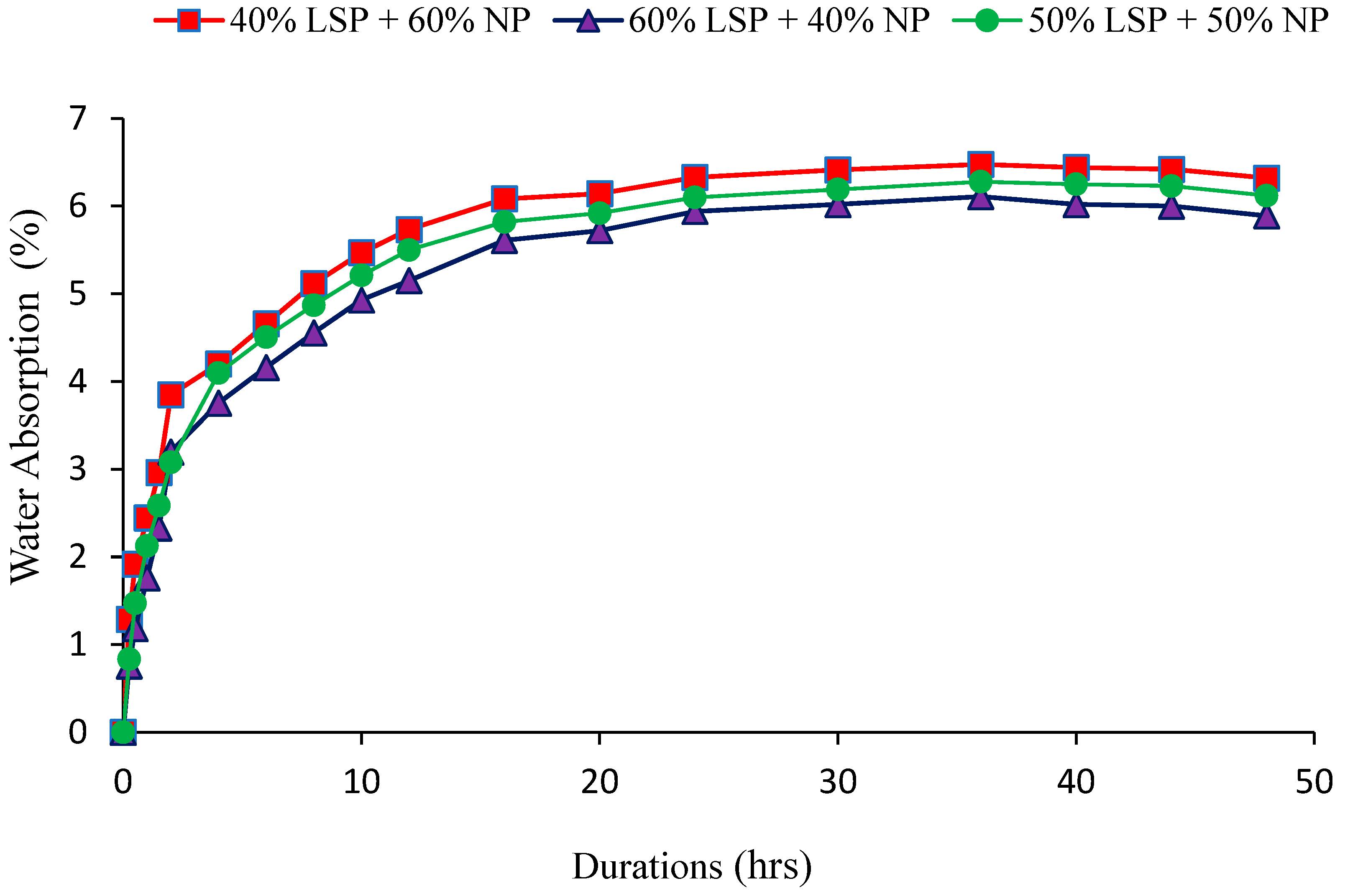
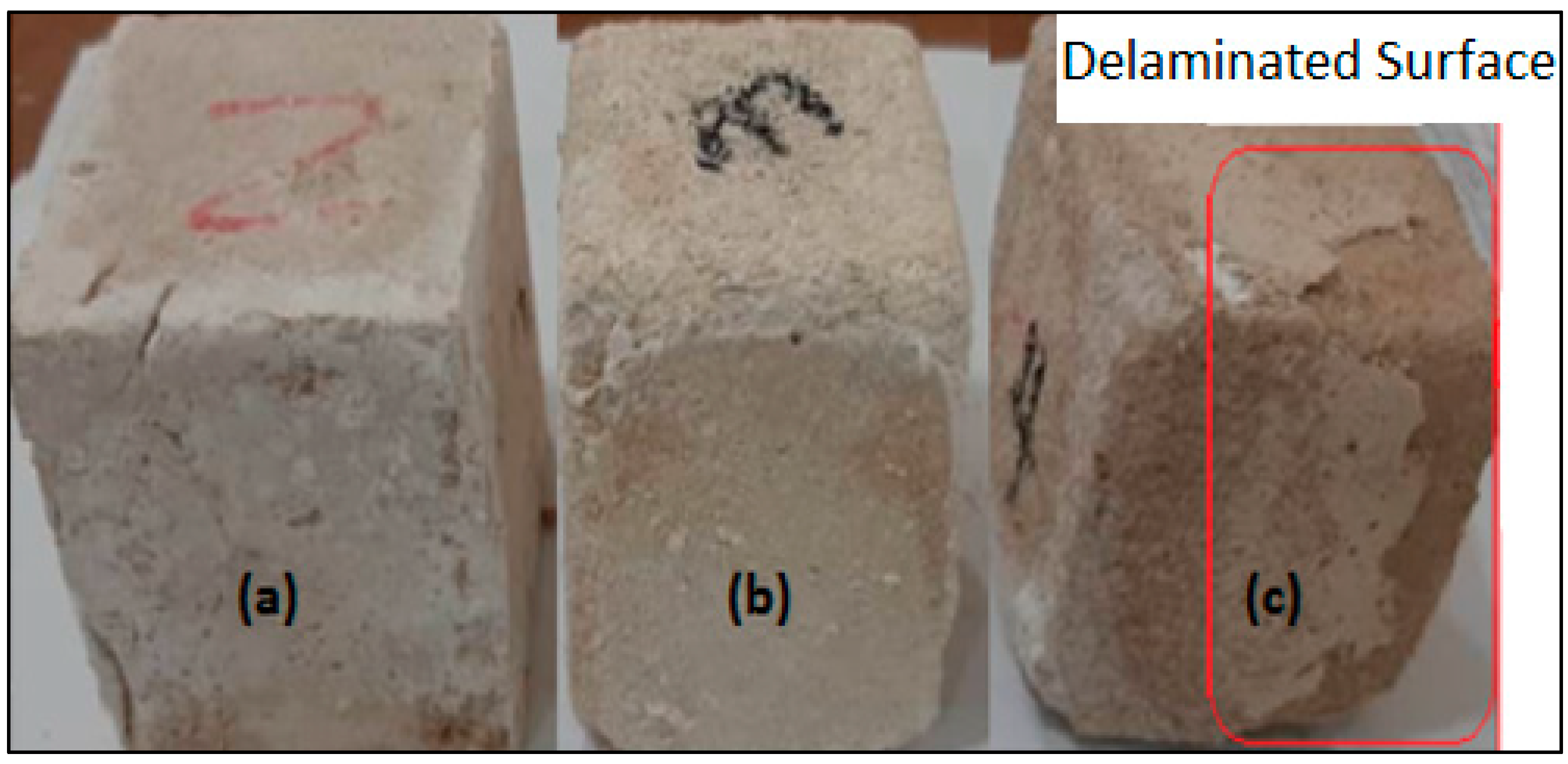
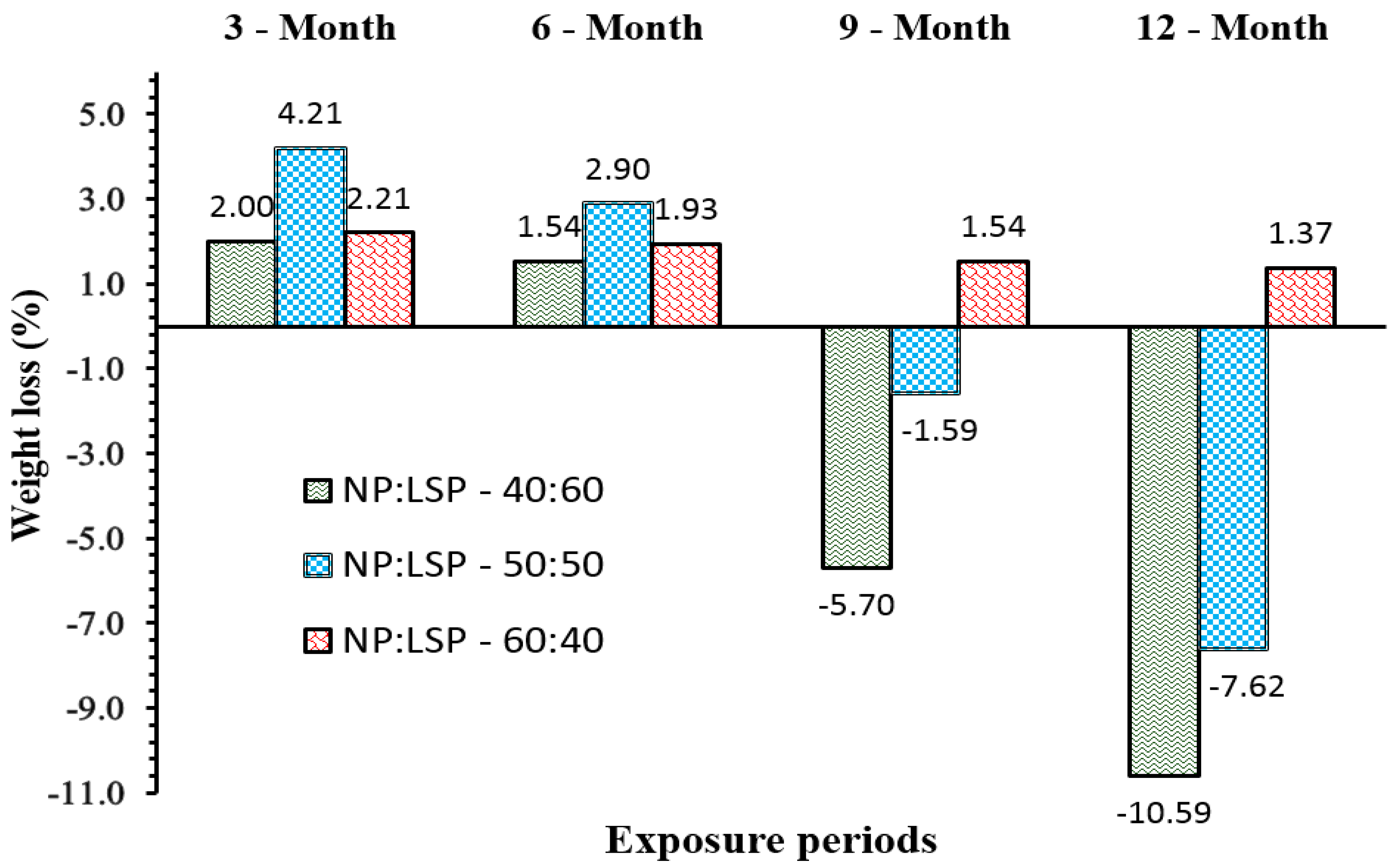
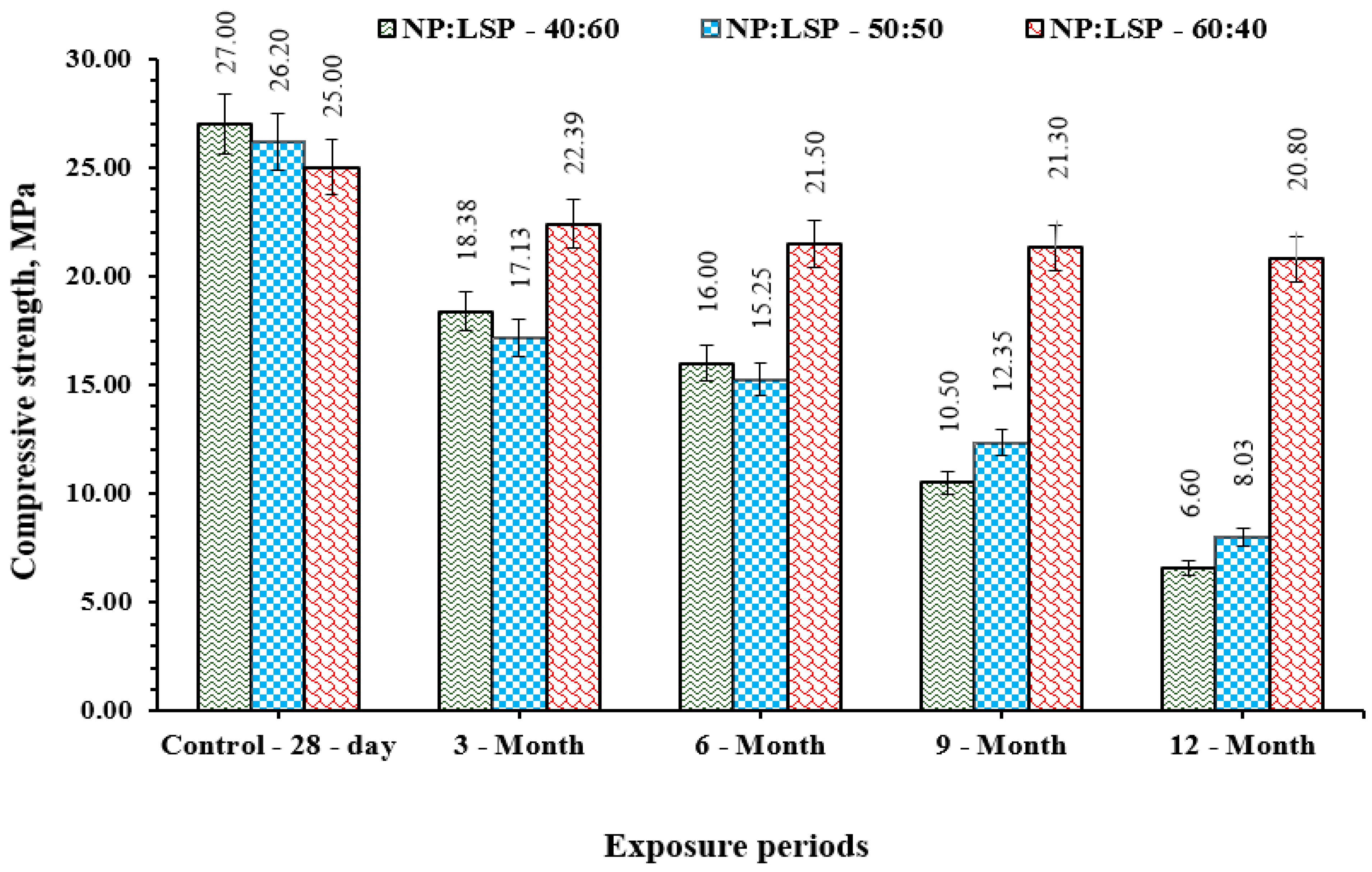

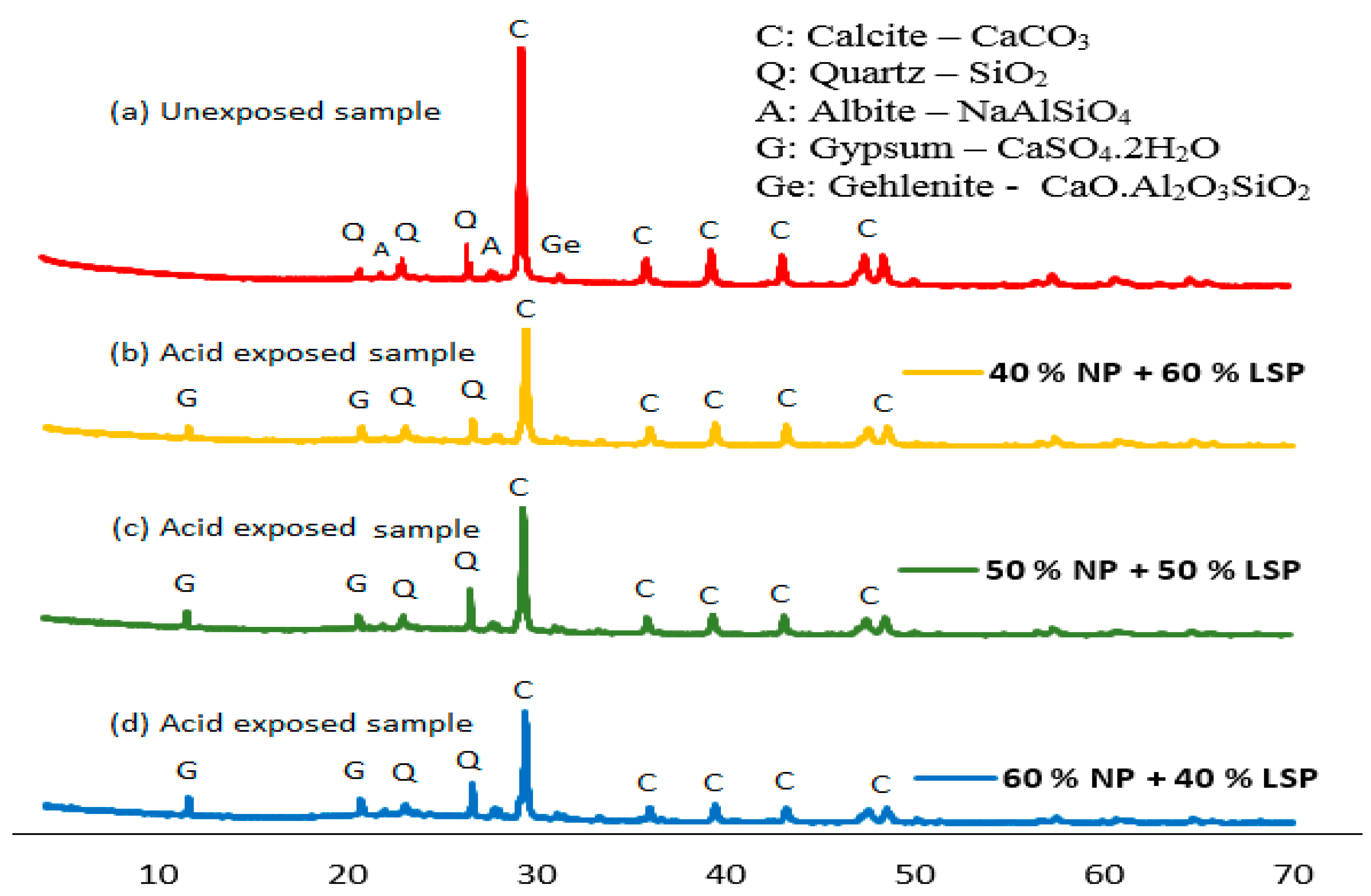
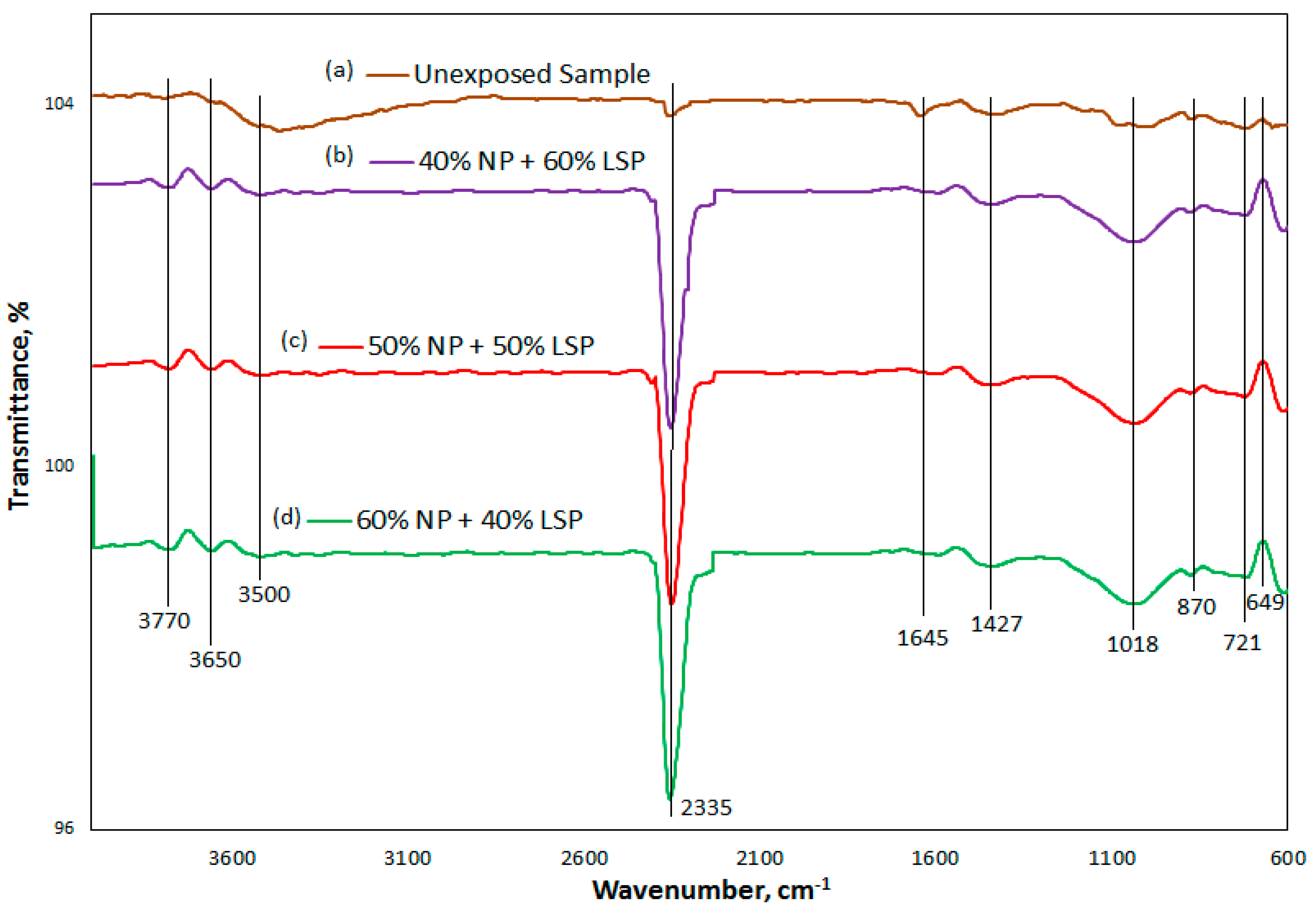



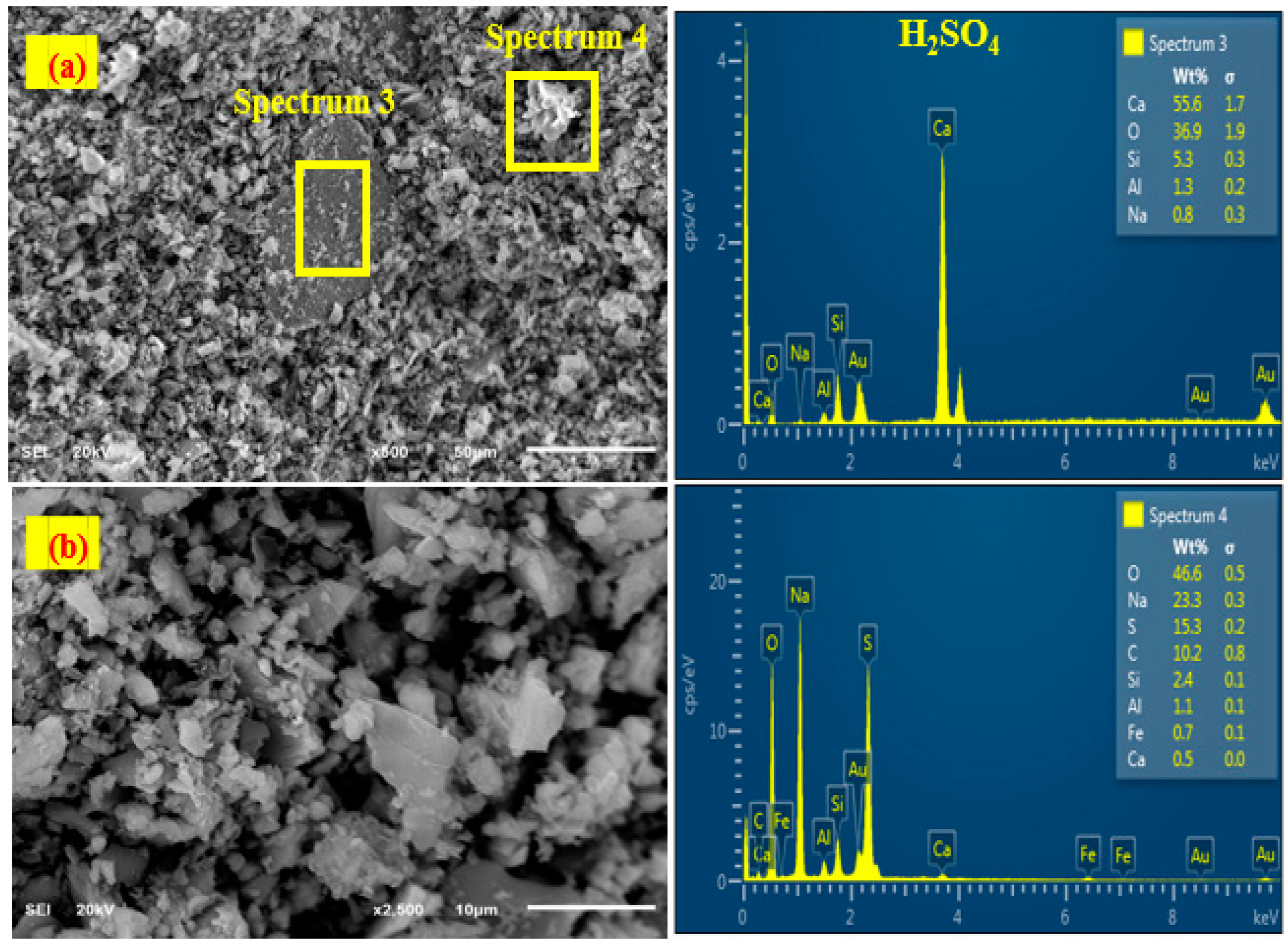
| Materials | Specific Gravity | Volume Mean Diameter (µm) | Specific Surface Area (cm2/g) | d90 (µm) | d50 (µm) | d10 (µm) |
|---|---|---|---|---|---|---|
| LSP | 2.7 | 12.1 | 0.6 | 31.0 | 6.4 | 1.20 |
| NP | 2.3 | 5.8 | 3.1 | 11.6 | 4.8 | 1.4 |
| Oxide Components (%) | CaO | SiO2 | Al2O3 | Fe2O3 | MgO | Na2O | K2O | L.O.I |
|---|---|---|---|---|---|---|---|---|
| NP | 2.0 | 74.0 | 13.0 | 1.5 | 0.5 | 4.0 | 5.0 | 5.0 |
| LSP | 94.1 | 2.5 | 0.8 | 1.2 | 0.6 | - | 0.3 | 44.0 |
| S/N | Sieve Size (mm) | Cumulative Passing (%) |
|---|---|---|
| 1 | 9.6 | 100 |
| 2 | 4.75 | 95 |
| 3 | 2.63 | 81 |
| 4 | 1.18 | 50.5 |
| 5 | 0.6 | 25.4 |
| 6 | 0.3 | 6.2 |
| 7 | 0.15 | 1.9 |
| Mix No. | Mix ID | NP | LSP | NH Molarity | SS/NH | SS | SH | H2O | Fine Aggregate |
|---|---|---|---|---|---|---|---|---|---|
| M1 | AAN60L40 | 363.0 | 242.0 | 10 | 1.0 | 151.5 | 151.5 | 60.5 | 1210 |
| M2 | AAN50L50 | 302.5 | 302.5 | 10 | 1.0 | 151.5 | 151.5 | 60.5 | 1210 |
| M3 | AAN40L60 | 242.0 | 363.0 | 10 | 1.0 | 151.5 | 151.5 | 60.5 | 1210 |
Publisher’s Note: MDPI stays neutral with regard to jurisdictional claims in published maps and institutional affiliations. |
© 2022 by the authors. Licensee MDPI, Basel, Switzerland. This article is an open access article distributed under the terms and conditions of the Creative Commons Attribution (CC BY) license (https://creativecommons.org/licenses/by/4.0/).
Share and Cite
Al-Sodani, K.A.A.; Adewumi, A.A.; Mohd Ariffin, M.A.; Salami, B.A.; Yusuf, M.O.; Ibrahim, M.; AlAteah, A.H.; Al-Tholaia, M.M.H.; Shamsah, S.M.I.; Ismail, M. Acid Resistance of Alkali-Activated Natural Pozzolan and Limestone Powder Mortar. Sustainability 2022, 14, 14451. https://doi.org/10.3390/su142114451
Al-Sodani KAA, Adewumi AA, Mohd Ariffin MA, Salami BA, Yusuf MO, Ibrahim M, AlAteah AH, Al-Tholaia MMH, Shamsah SMI, Ismail M. Acid Resistance of Alkali-Activated Natural Pozzolan and Limestone Powder Mortar. Sustainability. 2022; 14(21):14451. https://doi.org/10.3390/su142114451
Chicago/Turabian StyleAl-Sodani, Khaled A. Alawi, Adeshina A. Adewumi, Mohd Azreen Mohd Ariffin, Babatunde Abiodun Salami, Moruf O. Yusuf, Mohammed Ibrahim, Ali H. AlAteah, Mohammed M. H. Al-Tholaia, Sami M. Ibn Shamsah, and Mohammad Ismail. 2022. "Acid Resistance of Alkali-Activated Natural Pozzolan and Limestone Powder Mortar" Sustainability 14, no. 21: 14451. https://doi.org/10.3390/su142114451
APA StyleAl-Sodani, K. A. A., Adewumi, A. A., Mohd Ariffin, M. A., Salami, B. A., Yusuf, M. O., Ibrahim, M., AlAteah, A. H., Al-Tholaia, M. M. H., Shamsah, S. M. I., & Ismail, M. (2022). Acid Resistance of Alkali-Activated Natural Pozzolan and Limestone Powder Mortar. Sustainability, 14(21), 14451. https://doi.org/10.3390/su142114451










